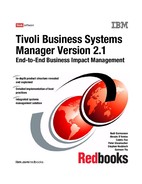
Chapter 11. z/OS data feeds and discovery 357
Figure 11-4 DB2 topology display
11.4 Information Management System (IMS)
The following sections describe the configuration steps for IMS data source
integration into IBM Tivoli Business Systems Manager.
11.4.1 Integration setup
The following steps must be completed before integration:
? “NetView-related setup” on page 358
? “IMS-related setup” on page 359
358 Tivoli Business Systems Manager Version 2.1: End-to-End Business Impact Management
NetView-related setup
IBM Tivoli NetView for z/OS should be changed as follows:
1. Modify DSIPARM members:
– Ensure that the include statement for the IMS message automation table
is uncommented in hlq.SGTMSAMP(IHS$MAT) for the line
%INCLUDE IHSIMAT
– Ensure that the include statement for the IMS command modules member
is uncommented in hlq.SGTMSAMP(IHS$CMD) for the line
%INCLUDE IHSICMD
– Ensure that the include statement for the IMS OPF member is
uncommented in hlq.SGTMSAMP(IHS$OPF) for the line
%INCLUDE IHSIMOPR
– Ensure that the GROUP authorization statements for the IMS operators
are uncommented in hlq.SGTMSAMP(IHS$CAT2) for operators started
with IHSI in the group NVOPS1 and NVOPS2.
2. The IHS$PARM member of hlq.SGTMSAMP may be modified to adjust such
polling and discovery parameters as:
IHSI.$ARCHTIME Default wait time (in minutes) for the IMS archive
log to run before a logging event is generated.
IHSI.$DBSINT Default interval between database status
checks.
IHSI.$LOGAVAIL Default minimum number of available IMS online
logs (OLDS) before an event is generated.
IHSI.$MSCINT Default interval for checking MSC links.
IHSI.$MTOINT Default interval for checking Master Terminal.
IHSI.$PGMINT Default interval for checking program status.
IHSI.$TXNINT Default interval for checking transaction status.
IHSI.$TXQLEN Default maximum queue length for transaction.
IHSI.$POLLTHRESHOLD Threshold on the number of messages to be
sent to Windows server to avoid message flood.
IHS$DISC_FROM Limit of initial discovery messages. Default is
500.
IHS$DISC_NVTCP/IP IP address of the MVS IP Listener. Our setup is
TCP/IP_ADDRESS=9.3.4.55.
Chapter 11. z/OS data feeds and discovery 359
3. The IHS$EXCL member of hlq.SGTMSAMP provides filtering of unnecessary
messages. The syntax of the file is:
TYPE NAME EVENTID SYSNAME COMMENT
with these variables:
TYPE Object class target
NAME Matching name of the object
EVENTID Message or event ID
SYSNAME OS identifier or SMFid
4. Estimate the number of NetView global variables required for each IMS region
using the formula provided in the Install and Configuration Guide and modify
accordingly the IBM Tivoli NetView for z/OS constants module, DSICTMOD.
5. IMS intergration makes use of EMCS consoles. Verify that your NetView
environment is set up to enable the MCS extended console interface. For
example, the MSGIFAC parameter in both the NetView subsystem interface
start procedure and in CNMSTYLE should be set to SYSTEM.
6. If you are running DBCTL regions and wish to suppress certain DFS™
messages from SYSLOG, review and run hlq.SGTMSAMP(IHS$MPF) to
modify MPF.
IMS-related setup
Perform the following steps to configure each IMS region.
1. Install the IMS Automated Operator (IMSAO) exit. Typically, IMS messages
are only sent to the IMS master terminal and do not get into the Subsystem
interface for monitoring from NetView. IBM Tivoli Business Systems Manager
uses an IMSAO type 2 exit called IHSIAOE0 to trap these messages. This exit
must be installed in each region. If your environment is such that other users
and/or products also require this exit interface, then an optional controller exit
(IHSIAOEC) can be installed that enables four other IMS AO type 2 exits to
coexist with IHSIAOE0. Perform the following steps to install the IMS AO exits:
a. Modify and run hlq.SGTMSAMP(IHSIAOML) to assemble and linkedit the
AO message table. The message table is stored in member IHSIAOMT of
SGTMSAMP.
b. Modify and run hlq.SGTMSAMP(IHSIAO0J) to linkedit the AO exit
IHSIAOE0.
c. If you need multiple IMSAO exits (for other automation software), you must
create the IHSIAOEC module. Modify hlq.SGTMSAMP(IHSIAOEE) that
contains the name of the modules for the IMSAO controller exit. Adapt and
run IHSIAOEJ and IHSIAOCJ to assemble and link-edit IHSIAOEE and
IHSIAOEC.

360 Tivoli Business Systems Manager Version 2.1: End-to-End Business Impact Management
These exits must be stored in the IMS RESLIB or concatenated in the
STEPLIB of the IMS Control Region. At the startup of the IMS Control Region,
the messages shown in Example 11-4 on page 360 indicate a successful
installation of the IHSIAOE0 exit.
Example 11-4 Messages from IHSIAOE0
IHS370I AO Exit IHSIAOE0 initialized for IMS v7.1.0 TM/DB system IMSQ
IHS371I Successfully loaded Message Table IHSIAOEM IMSQ
2. Enable Open Transaction Manager Access (OTMA). IBM Tivoli Business
Systems Manager integration uses OTMA for issuing IMS commands from
the IBM Tivoli Business Systems Manager console. To enable OTMA, you can
specify parameters at IMS startup as shown below.
S IMS710Q,PARM1='OTMA=Y,GRNAME=WTSCPLX1'
where GRNAME represents the Sysplex group name on which IMS runs.
The OTMA command interface program DFSYSVI0 also must be run
immediately after IPL, before any address space that uses OTMA is started.
You can achieve this by running the JCL stored in DFSYINIT in the IMS library
SDFSISRC. A sample is shown in Example 11-5.
Example 11-5 DFSYINIT
//OTMAINIT JOB ,'OTMA INITIALIZATION',CLASS=A,REGION=4M
//*
//IEFPROC EXEC PGM=DFSYSVI0
//*
//STEPLIB DD DISP=SHR,DSN=IMS710Q.SDFSRESL
//SYSPRINT DD SYSOUT=*
//SYSUDUMP DD SYSOUT=*
3. Configure IMS security. The NetView autotasks specific to IMS integration
(IHSIAUT0, IHSIAUT1, IHSIAUT2 and IHSIAUT3) must be defined as RACF
user IDs. These user IDs require the following access:
– Access to issue all IMS display commands through the OTMA interface
and for the EMCS interface for DBCTL regions. To enable OTMA interface
access, you can set the IMS startup parameter OTMASE=F (full security)
and tailor your security product to have access to IMS display commands.
– Access to IMSXCF.group.IHSI* RACF profile.
– Allocate temporary data sets.
– READ access to IMS data sets ACBLIB, MODBLKS, RESLIB and
PROCLIB.
– CONTROL access to recovery control (RECONxx) data sets.
– Access to run DSPURX00 (DBRC utility), which is usually protected using
the PROGRAM profile.
..................Content has been hidden....................
You can't read the all page of ebook, please click here login for view all page.
